Here are some of the most frequently asked questions and answers about the Santa Susana Field Laboratory (SSFL) cleanup, with a focus on questions regarding DTSC and its newly released draft Environmental Impact Statement (EIR) for the cleanup. Please also see our resources page, which has links to other organizational, community, and media stories about the cleanup. Click here to learn more about Boeing’s campaign to greenwash the cleanup.
What is SSFL and where is it located?
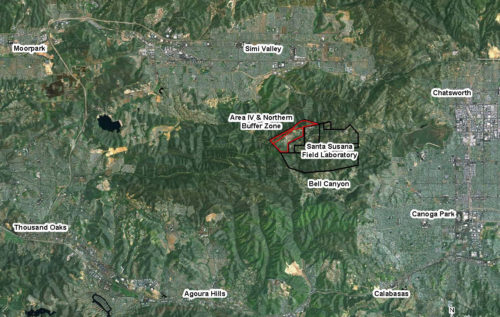 The Santa Susana Field Laboratory (SSFL), also known as Rocketdyne, is a former nuclear and rocket engine testing facility that is contaminated with radiological and chemical pollutants.
The Santa Susana Field Laboratory (SSFL), also known as Rocketdyne, is a former nuclear and rocket engine testing facility that is contaminated with radiological and chemical pollutants.
SSFL was established in the late 1940s by the Atomic Energy Commission as a testing facility (a “field laboratory”) for nuclear reactor development work too dangerous to perform close to a populated area. Over the following decades, however, the population mushroomed around the area. Currently, over half a million people reside within ten miles of the site.
The 2,850 acre SSFL site sits at an elevation of over 2,000 feet in the hills between Ventura and Los Angeles counties. Cities near SSFL include Simi Valley, Chatsworth, Canoga Park, Woodland Hills, West Hills, Westlake Village, Agoura Hills, Oak Park, Calabasas, and Thousand Oaks. (Click photo on right to enlarge.)
How did SSFL get contaminated?
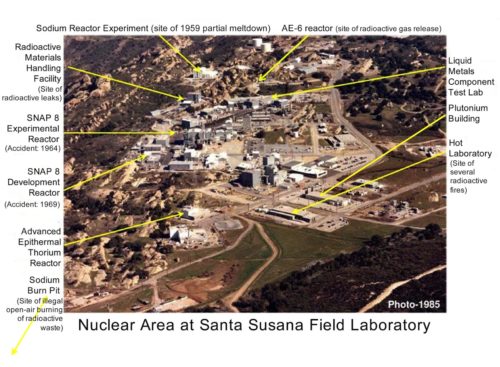 SSFL was home to ten nuclear reactors, half a dozen atomic critical facilities, a plutonium fuel fabrication facility, and a “hot lab” for decladding and disassembling highly irradiated nuclear fuel shipped in from around the Atomic Energy Commission/Department of Energy (DOE) national nuclear complex as an initial step for reprocessing.
SSFL was home to ten nuclear reactors, half a dozen atomic critical facilities, a plutonium fuel fabrication facility, and a “hot lab” for decladding and disassembling highly irradiated nuclear fuel shipped in from around the Atomic Energy Commission/Department of Energy (DOE) national nuclear complex as an initial step for reprocessing.
Numerous accidents, releases, and spills resulted. In 1959, the SRE reactor experienced a partial meltdown, in which a third of the fuel experienced melting. In 1964, a SNAP reactor suffered damage to 80% of its fuel. In 1968-9 another reactor suffered similar fuel damage. (See map to the left of SSFL’s nuclear area, click to enlarge.)
Several radioactive fires occurred in and at the Hot Lab. For decades, radioactively and chemically contaminated reactor components and other toxic wastes were routinely burned in open pits (the sodium “burn pit”) with airborne releases of contaminants as well as surface runoff of the pollutants offsite. In addition, tens of thousands of rocket tests were conducted at SSFL, resulting in significant chemical contamination.
What contaminants are at SSFL?
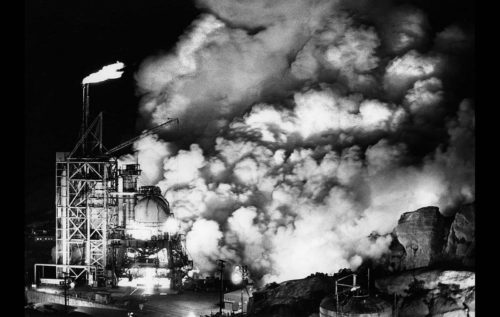 SSFL is contaminated with dangerous radionuclides such as cesium-137, strontium-90, plutonium-239 and tritium. In 2012, the U.S. EPA conducted an extensive radiological survey of SSFL and hundreds of soil samples came back positive for elevated levels of radioactivity. SSFL is also contaminated with highly toxic chemicals such as perchlorate, dioxins, PCBs, heavy metals, and volatile and semi-volatile organic compounds. In addition, hundreds of thousands of gallons of the extraordinarily toxic trichloroethylene (TCE) were used to flush out rocket test engines and then allowed to seep into the soil and groundwater.
SSFL is contaminated with dangerous radionuclides such as cesium-137, strontium-90, plutonium-239 and tritium. In 2012, the U.S. EPA conducted an extensive radiological survey of SSFL and hundreds of soil samples came back positive for elevated levels of radioactivity. SSFL is also contaminated with highly toxic chemicals such as perchlorate, dioxins, PCBs, heavy metals, and volatile and semi-volatile organic compounds. In addition, hundreds of thousands of gallons of the extraordinarily toxic trichloroethylene (TCE) were used to flush out rocket test engines and then allowed to seep into the soil and groundwater.
The contamination at SSFL is widespread, extending through all four operational areas and into the buffer zones and extending offsite. The radioactive and hazardous chemicals represent a witches’ brew of some of the most toxic substances on earth. Many of these materials are regulated at a few parts per billion (ppb), yet there are very large quantities present in the soil at SSFL. Perchlorate, an exceedingly toxic component of solid rocket boosters, is not permissible in drinking water, for example, at levels greater than 6 ppb. SSFL disposed of literally tons of perchlorate in open-air burnpits, polluting soil, groundwater and surface water. TCE is so dangerous that permissible levels in water are 5 parts per billion; 500,000 gallons are estimated to be polluting the SSFL soil column and aquifer.
What are the health impacts of SSFL contaminants?
 Exposure to SSFL contaminants can cause cancers and leukemias, developmental disorders, genetic disorders, neurological disorders, immune system disorders, and more. A study by the UCLA School of Public Health found significantly elevated cancer death rates among both the nuclear and rocket workers from exposures to these toxic materials. Another study by UCLA found that the rocket testing had led to offsite exposures to hazardous chemicals by the neighboring population at levels exceeding EPA levels of concern. A study performed for the federal Agency for Toxic Substances and Disease Registry found the incidence of key cancers were 60% higher in the offsite population near the site compared to further away.
Exposure to SSFL contaminants can cause cancers and leukemias, developmental disorders, genetic disorders, neurological disorders, immune system disorders, and more. A study by the UCLA School of Public Health found significantly elevated cancer death rates among both the nuclear and rocket workers from exposures to these toxic materials. Another study by UCLA found that the rocket testing had led to offsite exposures to hazardous chemicals by the neighboring population at levels exceeding EPA levels of concern. A study performed for the federal Agency for Toxic Substances and Disease Registry found the incidence of key cancers were 60% higher in the offsite population near the site compared to further away.
In addition, studies by cancer registries found elevated rates of bladder cancer associated with proximity to SSFL. A cluster of retinoblastoma cases, a rare eye cancer affecting young children, was identified within an area downwind of the site. And the Public Health Institute’s 2012 California Breast Cancer Mapping Project found that the rate of breast cancer is higher in Thousand Oaks, Simi Valley, Oak Park and Moorpark than in almost any other place in the state. Most recently, rare pediatric cancers have been identified by families who live near SSFL, causing tremendous concern.
It is important to note that the National Academy of Sciences’ Report on the Biological Effects of Ionizing Radiation found that there is no safe level of exposure to radiation. Children are more susceptible to radiation-induced cancer than adults, and girls are more radio-sensitive than boys. Similar increased risk of cancer for children and females has been found for many chemical carcinogens as well.
Why is it important that SSFL be fully cleaned up?
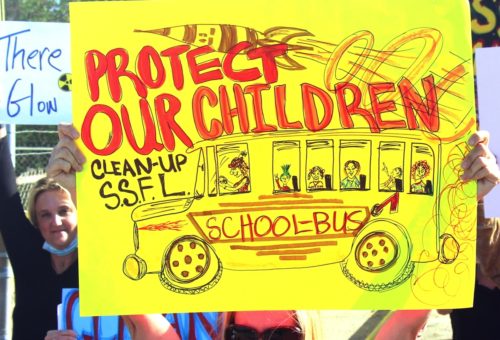 Contamination does not stay put on SSFL’s hilltop location. There have been over a hundred exceedances of pollution standards in runoff from the site reported to the LA Regional Water Quality Control Board, resulting in more than a million dollars in fines. A TCE groundwater plume extends offsite. Perchlorate, a component of solid rocket fuels that disrupts human development and which contaminates much of SSFL, has been found in numerous wells in Simi Valley and in soil and sediment in Dayton Canyon. Strontium-90 was found in Runkle Canyon. Other contamination has been found at Brandeis-Bardin and at Sage Ranch, where hundreds of cubic yards of toxic soil contaminated with antimony and asbestos had to be removed.
Contamination does not stay put on SSFL’s hilltop location. There have been over a hundred exceedances of pollution standards in runoff from the site reported to the LA Regional Water Quality Control Board, resulting in more than a million dollars in fines. A TCE groundwater plume extends offsite. Perchlorate, a component of solid rocket fuels that disrupts human development and which contaminates much of SSFL, has been found in numerous wells in Simi Valley and in soil and sediment in Dayton Canyon. Strontium-90 was found in Runkle Canyon. Other contamination has been found at Brandeis-Bardin and at Sage Ranch, where hundreds of cubic yards of toxic soil contaminated with antimony and asbestos had to be removed.
If the contamination is not cleaned up from its source at SSFL, it will continue to migrate offsite especially with wind and rain, which can carry it for miles. Future visitors to the site could be at risk too. Anyone who has ever hiked in the hills and mountains of Southern California knows that trails get dusty, and people can easily be in contact with the dust or even ingest it. Who would possibly want to bring children to a former nuclear meltdown site that hasn’t been fully cleaned up? Boeing’s risk assessment reports show high ecological risks too. In order to protect people and the environment, the contamination must be fully cleaned up.
Who is responsible for the SSFL cleanup?
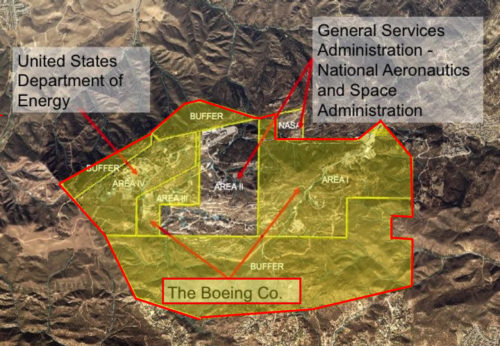 NASA, the Department of Energy (DOE), and Boeing are responsible for cleaning up their operational areas at SSFL. (See map to left, click to enlarge.)
NASA, the Department of Energy (DOE), and Boeing are responsible for cleaning up their operational areas at SSFL. (See map to left, click to enlarge.)
NASA owns and is responsible for cleaning up part of Area I and all of Area II, where the rocket engine testing took place.
The DOE is responsible for cleaning up Area IV, which it leases from Boeing. Area IV is where most of the nuclear activities occurred. DOE is also responsible for cleaning up the Northern Buffer Zone, which became part of SSFL in 1997 as part of a settlement between Boeing and the neighboring Brandeis-Bardin Institute, which sued over SSFL contamination polluting its property.
Boeing is responsible for cleaning up the rest of the 2,850 acre site.
Who is in charge of the SSFL cleanup?
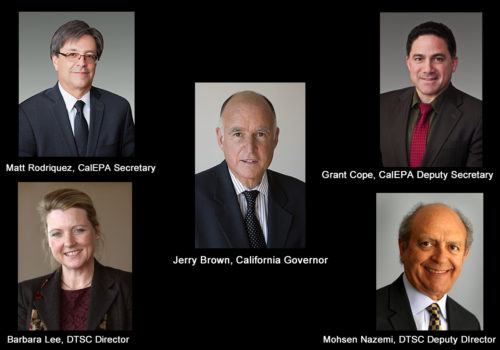 The California Department of Toxic Substances Control (DTSC), which is part of the California Environmental Protection Agency (CalEPA), has regulatory oversight for the SSFL cleanup. (CalEPA and DTSC leadership pictured right, click to enlarge.)
The California Department of Toxic Substances Control (DTSC), which is part of the California Environmental Protection Agency (CalEPA), has regulatory oversight for the SSFL cleanup. (CalEPA and DTSC leadership pictured right, click to enlarge.)
SSFL is in fact so contaminated that the U.S. EPA had recommended it for consideration as a federal Superfund site – a status granted to the most polluted sites in the country. However, because the State Superfund provided a better cleanup process, the state declined the dual listing. Community members were pleased because at the time, the DTSC was standing up to Boeing and repeatedly stated it would require a full health protective cleanup for SSFL.
But shortly after historic cleanup agreements were signed between DTSC, DOE, and NASA in 2010, the Brown Administration came into power. Boeing lobbyists included former senior aides to Brown, and immediately upon taking office, started to undermine the cleanup commitments.
- New DTSC leadership was brought in that was decidedly more friendly to Boeing.
- DTSC sabotaged its own defense in a Boeing lawsuit to overturn SB 990, a law passed by the State of California to help assure full cleanup. A lawyer for the state waived its right to contest any Boeing statement of purported material facts, weeks before they were even put forwarded, and thus without even having seen them. Many of these statements were outlandish and clearly false, but the state had given up the right to challenge them and Boeing prevailed in overturning the law.
- DTSC refused to continue the SSFL Work Group, the longtime public participation vehicle for the cleanup. Instead, over the objections of community members and elected officials, it approved a “Community Advisory Group” (SSFL CAG) led by people with ties to Boeing and the other responsible parties. (This was part of Boeing’s greenwashing campaign, which you can read about here.)
- DTSC, after pressure from a Boeing lobbyist, ignored the position of the agency leadership that radiologically contaminated materials from SSFL could not be disposed of in sites not properly licensed to receive it, and repeatedly allowed radioactive waste to be sent out for recycling and disposal in sites not designed for it. Several public interest groups sued, and a Superior Court judge issued a temporary injunction and denied Boeing’s request for summary judgment.
- In May 2017, DTSC denied that harmful SSFL contamination had migrated to the Brandeis-Bardin camp or anywhere, despite significant evidence to the contrary, essentially asserting absurdly that there was a magical glass wall around SSFL that blocked wind and rain from moving contamination offsite.
- DTSC is now backsliding on its own SSFL cleanup commitments, allowing DOE and NASA to propose options that violate their cleanup agreement and breaking its own commitments to hold Boeing to a comparable cleanup level.
SSFL is not the only community in California that DTSC is failing. In 2013, the report “Golden Wasteland” was published by Consumer Watchdog, enumerating the many different ways that DTSC has allowed polluters throughout the state to contaminate and not clean up. A year later Consumer Watchdog published “Inside Job” which specifically examines Boeing’s influence on DTSC.
What cleanup agreements are in place?
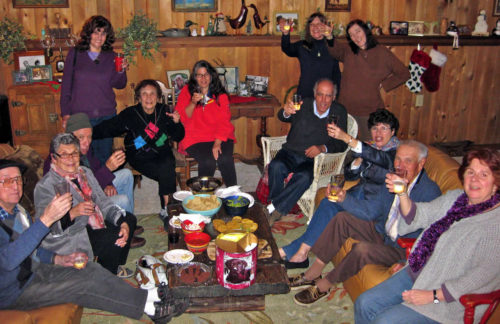 In 2010, the Department of Energy and NASA signed historic agreements called Administrative Orders on Consent (AOCs) with the California Department of Toxic Substances Control that committed them to clean up their operational areas to background levels of contamination – meaning return the land to the way it was before they polluted it. The AOC agreements specified that the cleanup was to be completed by 2017. The agreement was proposed by the then Dept. of Energy’s Nobel Prize winning Secretary, Dr. Steven Chu, and his Assistant Secretary of Environmental Management, Dr. Ines Triay. The community was thrilled. Finally, after decades of working for full cleanup, we had an agreement that would ensure that all detectable contamination would be cleaned up. (See photo, right, of community members raising their glasses in celebration.)
In 2010, the Department of Energy and NASA signed historic agreements called Administrative Orders on Consent (AOCs) with the California Department of Toxic Substances Control that committed them to clean up their operational areas to background levels of contamination – meaning return the land to the way it was before they polluted it. The AOC agreements specified that the cleanup was to be completed by 2017. The agreement was proposed by the then Dept. of Energy’s Nobel Prize winning Secretary, Dr. Steven Chu, and his Assistant Secretary of Environmental Management, Dr. Ines Triay. The community was thrilled. Finally, after decades of working for full cleanup, we had an agreement that would ensure that all detectable contamination would be cleaned up. (See photo, right, of community members raising their glasses in celebration.)
Boeing refused to sign the AOC cleanup agreements, and filed suit to overturn the state cleanup law for SSFL, SB 990. DTSC, however, said that even in the absence of SB990 or an AOC, its normal procedures require it to defer to local governments’ land use plans and zoning decisions which for SSFL allow agricultural and rural residential uses, which DTSC said would require a cleanup to background, equivalent to the AOC requirements.
Boeing resisted these standards, and said that it would instead cleanup to a weaker standard, suburban residential standard. It said that although it intended the land to be open space, it would clean the site up so it would be clean enough to live on, as a way of providing assurance to the people who lived nearby. (You might hear DTSC or Boeing mention that they are complying with “the 2007 consent order.” It is important to know that the 2007 consent order does NOT include an agreed upon cleanup standard, just the following of the routine procedures that in 2010 DTSC said required cleanup to the agricultural, background standard because of the County land use designations.)
In August 2017, Boeing broke its word, and abandoned its promise to suburban residential standard, saying it should only have to clean up to recreational standards – which amount to almost no cleanup at all. Recreational standards are based on people only being on the site for short amounts of time. But people who live near SSFL do not live in open space, and if high amounts of contamination remain on site, they will continue to be at risk of exposure to SSFL contamination through offsite migration.
What is an Environmental Impact Report (EIR)?
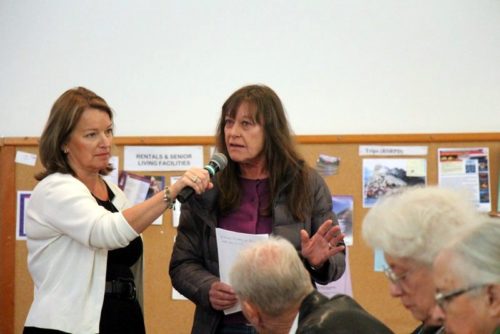 An Environmental Impact Report (EIR) is a report that must be prepared in California prior to any project that impacts the environment, per the California Environmental Quality Act (CEQA.) Projects undertaken by the federal government are required to produce a similar report called an Environmental Impact Statement (EIS) per the National Environmental Policy Act.)
An Environmental Impact Report (EIR) is a report that must be prepared in California prior to any project that impacts the environment, per the California Environmental Quality Act (CEQA.) Projects undertaken by the federal government are required to produce a similar report called an Environmental Impact Statement (EIS) per the National Environmental Policy Act.)
The purpose of an EIR or an EIS is to examine the impact of proposed projects and identify methods to minimize those effects. The process includes a public scoping period and a draft EIR which are both open for public review, a final EIR, and a Record of Decision. (Pictured right, Rocketdyne Cleanup Coalition member Holly Huff testifies at DTSC’s 2014 public scoping meeting for its EIR.)
NASA has completed its EIS for the SSFL cleanup in 2014, and DOE completed its Draft EIS in March 2017. (You can read about problems with DOE’s Draft EIS here.) Neither were actually required to do so, because NEPA is triggered by a discretionary action and NASA and DOE had signed binding cleanup agreements with the state of California. Both proposed alternatives that violated the agreements. The cleanup decisions rest with their regulator, DTSC, and are bound by the AOCS; NASA and DOE have tried to usurp that authority by doing their own EIS’s for cleanups far less protective than they had promised.
On September 7, 2017, DTSC released its draft EIR which covers the entire SSFL property, including all of the areas that NASA, DOE, and Boeing are responsible for cleaning up.
What’s wrong with the EIR for the SSFL cleanup?
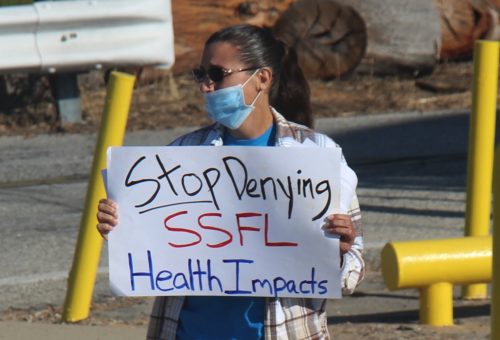 DTSC’s draft EIR is essentially a breach of the commitments DTSC had made to require a full cleanup. It includes proposals that would violate the AOC cleanup agreements it signed with DOE and NASA. For Boeing’s part of SSFL, the EIR blocks from even being considered cleanup to the standards DTSC hand long promised. Instead, it says the very best that would be done would be cleanup standards nearly thirty times less protective than DTSC’s own official residential cleanup levels, and far less than the promised cleanup to agricultural/rural residential and background standards.
DTSC’s draft EIR is essentially a breach of the commitments DTSC had made to require a full cleanup. It includes proposals that would violate the AOC cleanup agreements it signed with DOE and NASA. For Boeing’s part of SSFL, the EIR blocks from even being considered cleanup to the standards DTSC hand long promised. Instead, it says the very best that would be done would be cleanup standards nearly thirty times less protective than DTSC’s own official residential cleanup levels, and far less than the promised cleanup to agricultural/rural residential and background standards.
Amazingly, the EIR has a thousand pages of all the supposed negative impacts of doing a cleanup, but nothing on the negative impacts of the contamination and the health and environmental harm that would occur if the pollution isn’t cleaned up. By omitting cancer risk information and hyping potential negative impacts of the cleanup, the EIR presents a biased and inaccurate assessment of the SSFL cleanup. It is essentially a PR attack on the cleanup commitments DTSC itself had made.
If that sounds like something Boeing would produce, it’s because in large part it did – the EIR was written by Boeing’s consultant, hardly an honest broker! Indeed, DTSC allowed Boeing and the other responsible parties, DOE and NASA, to write and edit significant parts of what is supposed to be DTSC’s independent environmental review.
Here are more key problems:
- DTSC’s EIR contemplates leaving large amounts of contamination in place, which it refers to as “natural attenuation.” This means just leaving the toxic materials and hoping they lessen over long periods of time. It also violates the AOC cleanup agreements, which prohibit even considering leaving contamination in place.
- DTSC’s EIR says that it intends to exempt from cleanup unspecified but apparently huge amounts of contamination for purported biological and cultural reasons, which appear to be far beyond the narrow exemptions allowed under the cleanup agreements. The real threat to the ecology – which is not examined at all in the EIR – is the radioactive and chemical contamination, which needs to be cleaned up to protect ecological features as well as people.
- Though DTSC in 2010 promised a cleanup for Boeing’s property that would be equivalent to that required for DOE and NASA, the EIR now says Boeing will be allowed to do a less protective than that in the DOE and NASA agreements. Furthermore, it excludes from consideration a cleanup to background or to the rural residential standards previously promised.
- The EIR even excludes consideration of DTSC’s own official suburban residential standard, and puts forward instead one that is nearly thirty times less protective. In other words, the very best DTSC is now considering would leave contamination concentrations nearly thirty times higher than DTSC’s own official goals for what is safe for suburban residences, and far higher than even that compared to the cleanup levels DTSC has long promised. Furthermore, the EIR indicates that Boeing will be allowed to also leave large amounts of contamination in place, for similar “natural attenuation” and unspecified biological and cultural exemptions.
- The EIR also fails to disclose what DTSC is actually proposing to not clean up. It is absurd to release a report that gives no real information about what the proposed cleanup amounts will be. DTSC hides the ball—it keeps hidden how much contaminated soil it contemplates not cleaning up, saying that it will disclose that only after the EIR is finalized. This flies in the face of environmental law, which is to disclose and analyze in the EIR, not shielding from public view its intentions until after the EIR is over. And by only giving information about supposed impacts to the environment from cleanup and excluding information on risks to health and the environment from the contamination itself and from not cleaning it all up as promised, the DEIR misrepresents all risks.
- Along with the draft EIR, DTSC released a Program Management Plan (PMP) for review. Buried in the PMP is that outrageous statement that DTSC now projects that the cleanup will not be completed until 2034! That is 17 years after the AOC requirement of 2017 and nearly 90 years from when the contamination first began being created. It is absolutely unacceptable.
Will, as Boeing claims, a full cleanup cause harm?
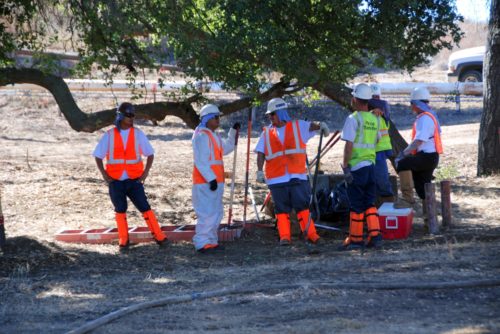 Boeing’s new propaganda website–outrageously called “Protect Santa Susana,” when it is of course Boeing and its predecessors that re responsible for the toxic damage to Santa Suana–claims that DTSC’s draft EIR only considers “excessive” cleanup alternatives that “would unnecessarily require the local community to live with decades of transportation and air quality impacts, and destroy critical wildlife habitat and disturb Native American artifacts in the process.”
Boeing’s new propaganda website–outrageously called “Protect Santa Susana,” when it is of course Boeing and its predecessors that re responsible for the toxic damage to Santa Suana–claims that DTSC’s draft EIR only considers “excessive” cleanup alternatives that “would unnecessarily require the local community to live with decades of transportation and air quality impacts, and destroy critical wildlife habitat and disturb Native American artifacts in the process.”
This is simply not true. First, we must point out that Boeing wasn’t concerned about trucks when SSFL was trucking in large quantities of highly radioactive reactor fuel and other toxic materials from around the country for decades. And it would have been nice if Boeing and the other responsible parties had been concerned about the environment during the over five decades that they wantonly and recklessly polluted the site with radiological and chemical contamination by violating fundamental norms of environmental protection. But now that its time to clean up their toxic mess, now they have magically turned into environmentalists? Give us a break.
The majority of the areas in SSFL that need to be cleaned are areas already disturbed. These are areas where nuclear reactors, buildings that handled radioactive materials, toxic burn pits, and rocket test stands are located. The contamination occurred primarily where topsoil had already been scraped away, where structures were constructed, and huge amounts of pollutants were just dumped in the soil.
If there are any truly sensitive areas, great care is taken not to disturb them during cleanup. (See photo above from 2010, when NASA remediated contaminated soil near a former incinerator and ash pile at SSFL. Some cleanup occurred around oak trees. The contractor noted, “We got at the soil we needed to with very minimal disturbance to the surrounding environment. No oak tree roots were exposed or damaged during the soil removal.”)
In addition, the AOC cleanup agreements provide protection for officially recognized Native American artifacts, as well as endangered plants and animals if a US Fish & Wildlife Biological Opinion directs particular protection. As they said in a prior Biological Opinion, cleaning up the contamination is critical to protect biological features. Thus the greatest risk is if the site isn’t cleaned up and the critters are continued to be exposed to radioactive and toxic chemical pollution.
The responsible parties have been hyping truck traffic for years now in a blatant attempt to manipulate the community into opposing the cleanup. In response, the community has urged them to consider alternative methods such as conveyor to rail, and alternative routes. DOE’s EIS refused to do either. DTSC’s EIR fails to take an honest look at these alternatives.
By far the greatest risk to the community and environment is if the contamination doesn’t get cleaned up, posing a risk both onsite and from contamination migrating offsite. That is why it must all be cleaned up—AS PROMISED.
How can I help ensure SSFL is fully cleaned up?
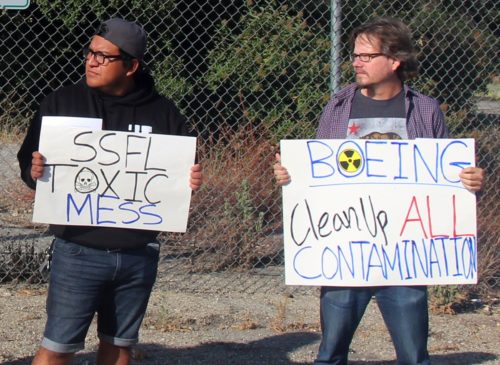 Despite Boeing’s slick greenwashing campaign and well-heeled lobbyists, and despite DTSC’s tendency to act like its job is to protect the polluter, instead of the public, communities who live near SSFL have a powerful voice and a critical role to play in making sure that SSFL is fully cleaned up.
Despite Boeing’s slick greenwashing campaign and well-heeled lobbyists, and despite DTSC’s tendency to act like its job is to protect the polluter, instead of the public, communities who live near SSFL have a powerful voice and a critical role to play in making sure that SSFL is fully cleaned up.
Though the December 14 deadline to submit comments on DTSC’s draft PEIR for the SSFL cleanup has passed, you can still take action:
